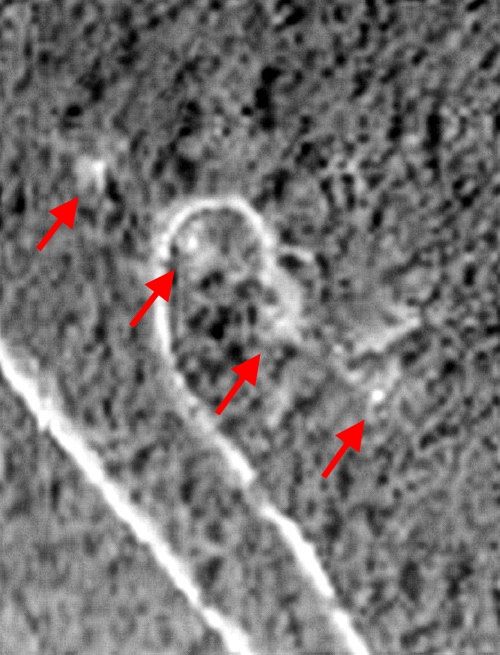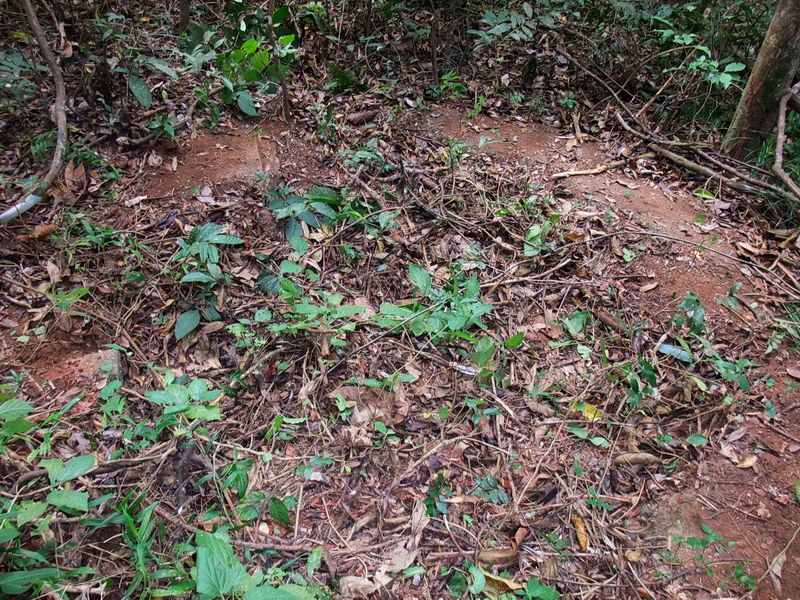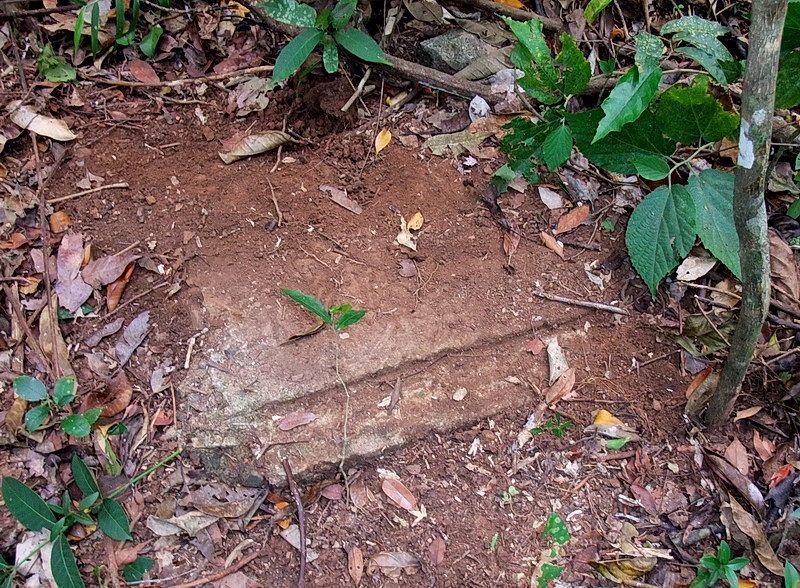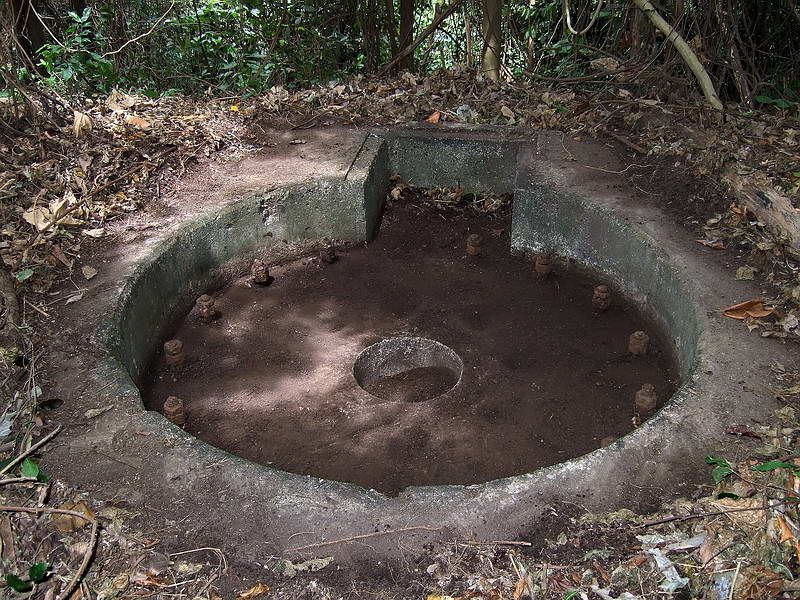Post by fots2 on Mar 25, 2013 20:28:16 GMT 8
As time passes low-profile structures on Corregidor are getting much more difficult to find. The usual MO is to use detailed maps which will show you where something was located and GPS to get you very close. Once there, those aids are of little use so you have to resort to wandering around while kicking away at the soil, leaves and branches. In recent years the emergence of dense vegetation in some places has hindered the process. All this is normal and part of the fun but what if the information you are following is flawed. Here is one example from the Battery Chicago area on top of Morrison Hill. In this specific case, the Army Corps of Engineer’s map is incorrect.
I have been on Morrison Hill several times but have been unable to locate all of the pre-war 3-inch AA gun blocks. There are five in total, four in a straight line and a fifth one off to the side. Note that none of these gun blocks were ever used by Battery Chicago’s mobile 3-inch guns.
So how do I know that the map is wrong? Awhile ago I was looking at an old black and white aerial photo of Corregidor. Along Morrison Hill I saw four white dots in a line which were the gun blocks reflecting sunlight. Something that caught my eye was that some of the dots seemed to be on the wrong side of the road which disagreed with the map. No wonder I had never found a couple of them, I was searching on the wrong side of the road. A return trip back there might give me better results next time.

Zoomed in view of a pre-war aerial photo. The four in-line AA gun blocks are labeled with red arrows.

The same gun blocks as shown on the map.

Side by side comparison. Note the positions of the gun blocks in relation to the road in both views.
The return trip came earlier this year. Karl and I had some extra time during one of our treks so on the way back to Bottomside we detoured to Morrison Hill. Using the printed photo and the road as references, we walked towards a gun block that I have never found. Within seconds we saw traces of concrete right where it should be. It took awhile to clear the spot but there was no question that this was what I was searching for. The gun block is nearly completely buried now.

After clearing away the bushes etc, here is a look at the AA gun block with its circular concrete ring. It is completely filled with soil these days. The concrete notch (keyhole) can barely be seen at the top of the photo.

Close-up of part of the groved concrete keyhole.
These photos do not show much so here is a look at a cleaned out AA gun block of the same design. This one is at Denver Hill on Tailside. Thanks to Phantom for the excellent clean-up job.

We know where most of the gun blocks are but we searched for a second one that day. It was not found due to thick vegetation. Standing at the edge of it I took this photo looking down at a 45 degree angle, you cannot even see your feet here. God knows what slithering creatures are in there just daring me to step on their tails. That could really ruin my day.

Thick vegetation in the area where we looked for the second gun block.
After awhile we gave up and moved on. As a shortcut back to Bottomside, we walked directly down Morrison Hill past the Japanese AA gun and out onto the North Shore Road above the Power Plant. From here it is an easy stroll to our favorite chairs at MacArthur’s Cafe.
Finally, here is a look at the model of 3-inch Anti-aircraft gun that would have sat on these keyhole gun blocks.

I have been on Morrison Hill several times but have been unable to locate all of the pre-war 3-inch AA gun blocks. There are five in total, four in a straight line and a fifth one off to the side. Note that none of these gun blocks were ever used by Battery Chicago’s mobile 3-inch guns.
So how do I know that the map is wrong? Awhile ago I was looking at an old black and white aerial photo of Corregidor. Along Morrison Hill I saw four white dots in a line which were the gun blocks reflecting sunlight. Something that caught my eye was that some of the dots seemed to be on the wrong side of the road which disagreed with the map. No wonder I had never found a couple of them, I was searching on the wrong side of the road. A return trip back there might give me better results next time.

Zoomed in view of a pre-war aerial photo. The four in-line AA gun blocks are labeled with red arrows.

The same gun blocks as shown on the map.

Side by side comparison. Note the positions of the gun blocks in relation to the road in both views.
The return trip came earlier this year. Karl and I had some extra time during one of our treks so on the way back to Bottomside we detoured to Morrison Hill. Using the printed photo and the road as references, we walked towards a gun block that I have never found. Within seconds we saw traces of concrete right where it should be. It took awhile to clear the spot but there was no question that this was what I was searching for. The gun block is nearly completely buried now.

After clearing away the bushes etc, here is a look at the AA gun block with its circular concrete ring. It is completely filled with soil these days. The concrete notch (keyhole) can barely be seen at the top of the photo.

Close-up of part of the groved concrete keyhole.
These photos do not show much so here is a look at a cleaned out AA gun block of the same design. This one is at Denver Hill on Tailside. Thanks to Phantom for the excellent clean-up job.

We know where most of the gun blocks are but we searched for a second one that day. It was not found due to thick vegetation. Standing at the edge of it I took this photo looking down at a 45 degree angle, you cannot even see your feet here. God knows what slithering creatures are in there just daring me to step on their tails. That could really ruin my day.

Thick vegetation in the area where we looked for the second gun block.
After awhile we gave up and moved on. As a shortcut back to Bottomside, we walked directly down Morrison Hill past the Japanese AA gun and out onto the North Shore Road above the Power Plant. From here it is an easy stroll to our favorite chairs at MacArthur’s Cafe.
Finally, here is a look at the model of 3-inch Anti-aircraft gun that would have sat on these keyhole gun blocks.







